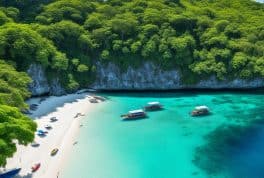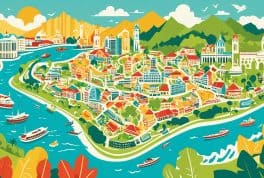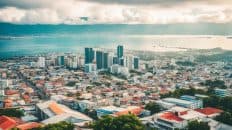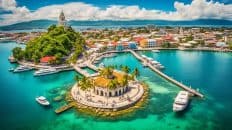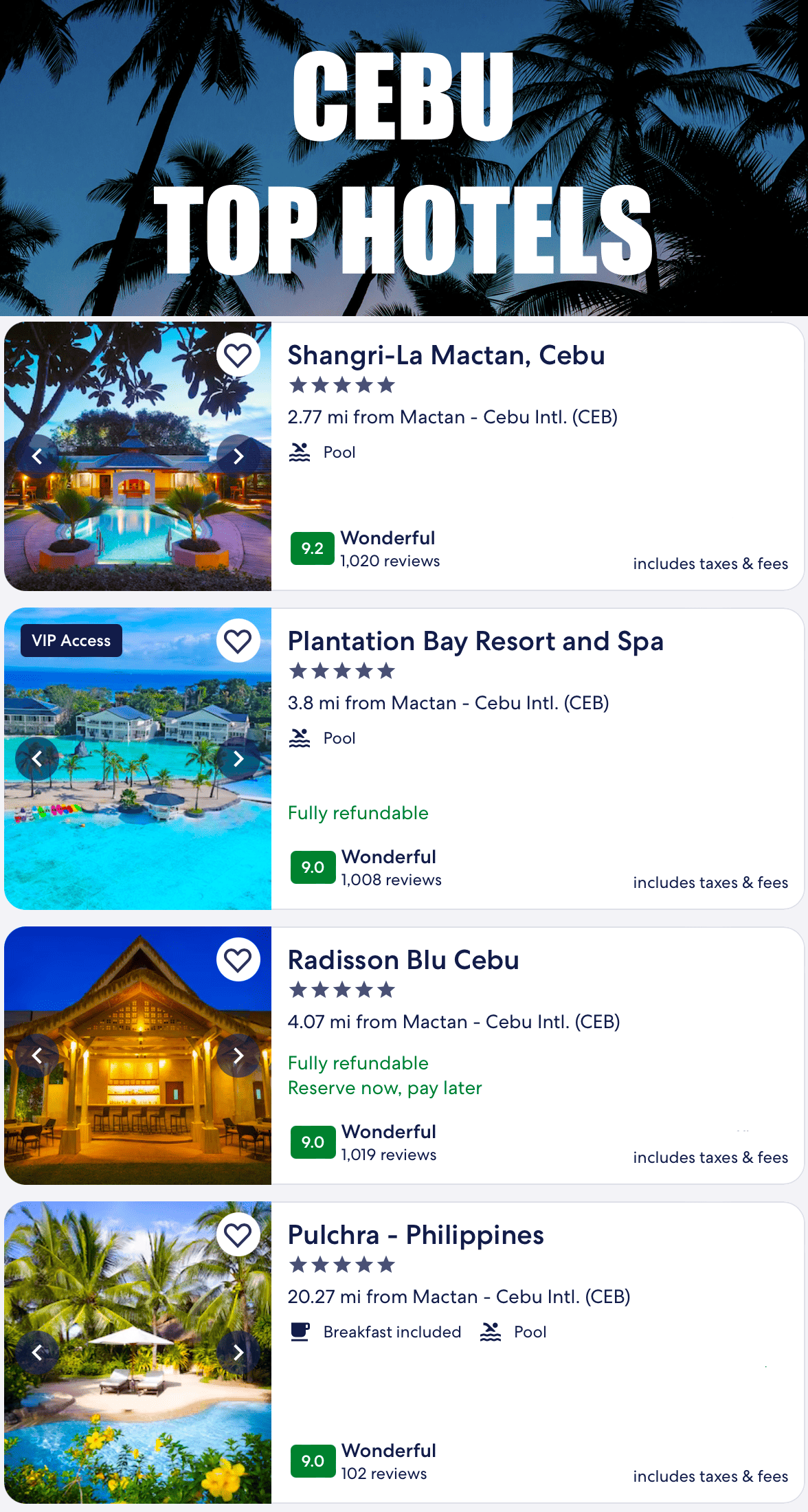Cebu Island
Cebu, the Queen City of the South, holds an enchanting blend of rich cultural heritage, captivating landscapes, and modern urban flair. It's not just an island - it's a pulsating heart of the Philippines, offering a microcosm of the country's best. From historical landmarks that reverberate tales of centuries gone by to natural wonders that leave you spellbound, Cebu is where stories come alive.
Start Here! - Beautiful Tour of Cebu
Table of Contents
Articles About Cebu
Top 10 Things to See in Cebu
Cebu, an island province in the Philippines, is known for its rich history, stunning landscapes, and vibrant culture. Here are the top 10 things to see and experience in Cebu:
- Kawasan Falls: A breathtaking multi-layered waterfall famous for its turquoise blue waters, located in Badian.
- Santo Niño Basilica: A historical and religious landmark in Cebu City, home to the revered statue of the Santo Niño (Holy Child).
- Magellan's Cross: A significant historical marker in Cebu City, believed to have been planted by explorers led by Ferdinand Magellan.
- Tops Lookout: Offers panoramic views of Cebu City and the surrounding islands, especially beautiful at sunset.
- Oslob Whale Shark Watching: A unique opportunity to swim with the gentle giants of the sea, the whale sharks, in the waters off Oslob.
- Tumalog Falls: A picturesque and serene waterfall located near Oslob, known for its gentle cascade and natural pool.
- Temple of Leah: A grand temple built as a symbol of love, offering stunning architecture and views of the city.
- Mactan Island: Known for its world-class resorts, beaches, and diving spots, as well as being the site of the Battle of Mactan.
- Moalboal Sardine Run: A marine spectacle where you can snorkel or dive among millions of sardines in the waters of Moalboal.
- Fort San Pedro: A historical military defense structure in Cebu City, offering insights into the island's colonial past.
Each of these destinations offers a unique glimpse into the diverse attractions that Cebu has to offer, from natural wonders to historical sites.
Guides and Tours
Top 10 Questions and Answers about Cebu
What is Cebu known for?
Cebu is known for its rich history, beautiful beaches, and the Sinulog Festival. It’s also famous for its delicious mangoes and as the site where Ferdinand Magellan landed in the Philippines in 1521.
What language is spoken in Cebu?
The primary language spoken in Cebu is Cebuano, also known as Bisaya. However, most people are fluent in English and Tagalog as well.
What are the top tourist attractions in Cebu?
Popular tourist spots include the Basilica del Santo Niño, Magellan’s Cross, the beaches of Mactan Island, Kawasan Falls, and Osmeña Peak.
What is the best time to visit Cebu?
The best time to visit is between December and May when the weather is dry and sunny. January is particularly festive due to the Sinulog Festival.
What is the Sinulog Festival?
Sinulog is a cultural and religious festival held on the third Sunday of January in Cebu City. It celebrates the Filipino people’s pagan past and their conversion to Christianity.
What are the food specialties of Cebu?
Cebu is famous for its lechon (roasted pig), dried mangoes, and seafood. Street food and local delicacies like puso (hanging rice) are also must-tries.
Public transportation includes jeepneys, buses, and taxis. Renting a car or
Public transportation includes jeepneys, buses, and taxis. Renting a car or motorcycle is also an option for more flexibility.
What are the best shopping places in Cebu?
Ayala Center Cebu, SM City Cebu, and Carbon Market are popular shopping destinations offering a mix of high-end brands, local products, and street market experiences.
Are there any cultural etiquette tips for visiting Cebu?
Respect local customs and traditions, dress modestly when visiting religious sites, and always ask permission before taking photos of people.
Is Cebu safe for tourists?
Cebu is generally safe for tourists, but it’s always advisable to take standard safety precautions, such as guarding personal belongings and avoiding less crowded areas at night.
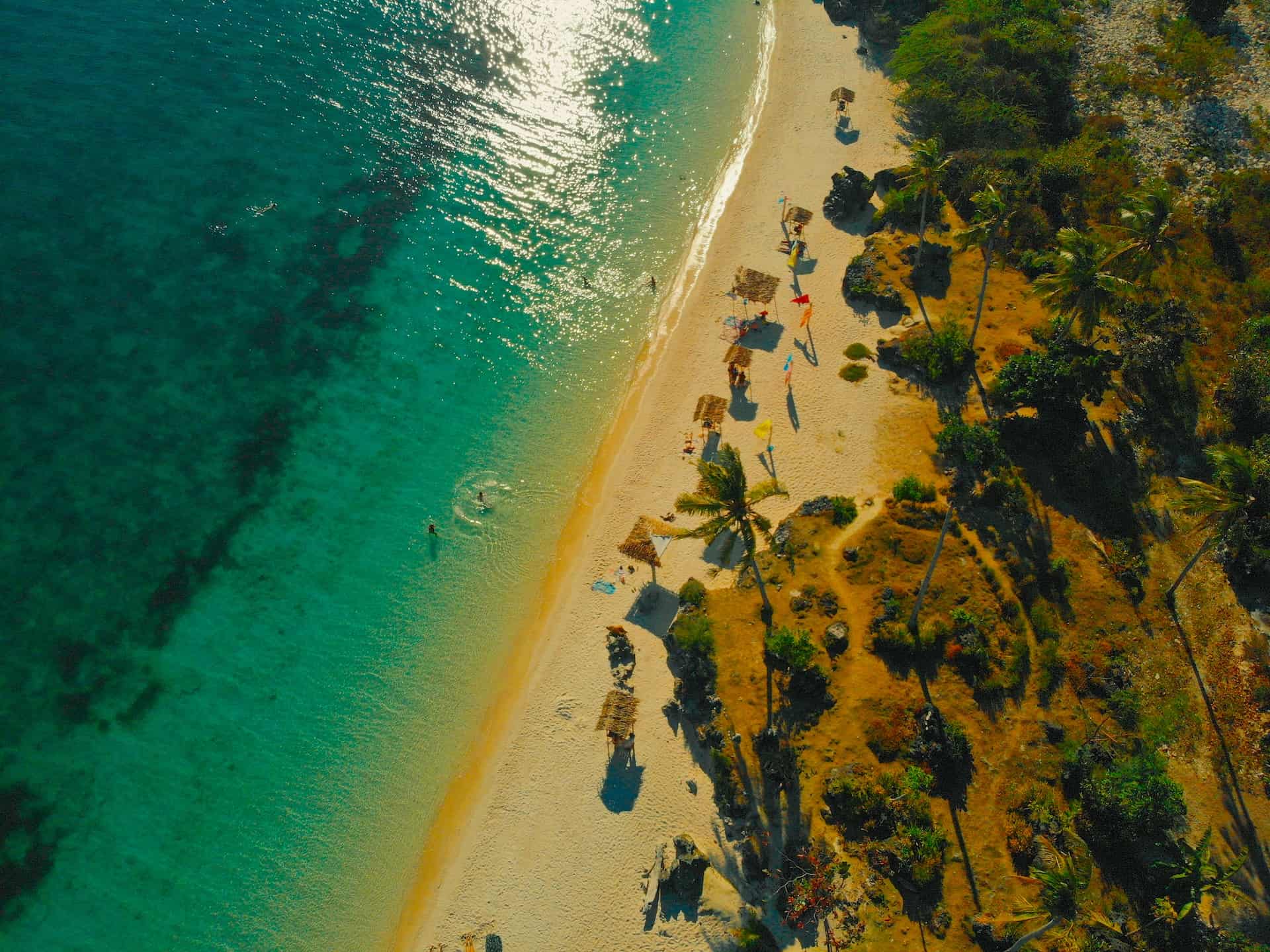
Why You Should Visit Cebu
Exploring the Jewel of the Philippines: Why Cebu Should Be Your Next Destination
The Enchantment of Cebu's Natural Beauty
Cebu, often referred to as the "Queen City of the South" in the Philippines, is an enchanting blend of urban sophistication and natural splendor. One cannot help but be mesmerized by its lush landscapes, pristine beaches, and the gentle hum of its vibrant culture. The island's natural beauty is undeniably one of its biggest draws. From the moment you step onto its shores, you are greeted by the warm, tropical breeze and the soft, rhythmic sounds of waves.
Take, for instance, the Kawasan Falls in Badian, a sight to behold with its cascading turquoise waters set against a backdrop of lush greenery. The falls offer a refreshing escape from the tropical heat, inviting visitors to swim in its cool, crystal-clear waters. And then there's the serene beauty of Tumalog Falls near Oslob, a less crowded but equally captivating destination, where the water gently descends like a delicate veil over the mossy rocks.
The Rich Tapestry of History and Culture
Cebu's history is as colorful as its landscapes. The island is a treasure trove of historical landmarks, each telling a story of its rich and varied past. The Basilica Minore del Santo Niño, for instance, is not just a religious landmark but a symbol of Cebu's deep-rooted Christian faith. The church houses the revered Santo Niño statue, a remnant of the Spanish colonial era and an object of devotion for many Filipinos.
A short walk from the basilica leads you to Magellan's Cross, another historical gem. Planted by Portuguese and Spanish explorers led by Ferdinand Magellan in 1521, this cross symbolizes the birth of Christianity in the Philippines. It's a testament to Cebu's pivotal role in the country's colonial history.
Urban Delights and Culinary Adventures
Cebu is not just about natural beauty and historical sites; it's also a bustling urban center with a thriving culinary scene. The city is a melting pot of flavors, offering everything from traditional Filipino dishes to international cuisine. One must-try is the famous Cebuano lechon, known for its crispy skin and succulent meat, seasoned with a blend of local spices.
Shopping and nightlife in Cebu are also experiences not to be missed. From high-end malls to local markets, Cebu offers a shopping experience for every kind of traveler. As night falls, the city comes alive with bars and clubs, each offering a unique vibe and energy.
The Thrill of Adventure and the Call of the Sea
For the adventure seekers, Cebu is a playground waiting to be explored. The sardine run in Moalboal is a unique underwater spectacle where divers can swim alongside millions of sardines, an experience that is both exhilarating and surreal. Meanwhile, Oslob offers the once-in-a-lifetime chance to swim with whale sharks, the gentle giants of the sea.
Cebu's Mactan Island, renowned for its luxurious resorts and world-class diving spots, is a haven for beach lovers and divers. The island's clear waters are teeming with marine life, offering a peek into an underwater world of colorful corals and exotic fish.
The Warmth of Cebuano Hospitality
What truly sets Cebu apart, however, is the warmth and hospitality of its people. Cebuanos are known for their friendliness and welcoming nature, making visitors feel right at home. Whether you're navigating through the bustling city streets or exploring remote natural wonders, you'll find that the locals are always ready with a smile and a helping hand.
Cebu's festivals, particularly the Sinulog Festival, are a vibrant display of this warm hospitality. Sinulog, held every January, is a colorful and lively celebration in honor of the Santo Niño. It's a spectacle of dance, music, and cultural pride, showcasing the Cebuanos' deep devotion and joyful spirit.
Conclusion: The Endless Wonders of Cebu
In conclusion, Cebu is more than just a destination; it's an experience that stays with you long after you've left its shores. From its stunning natural wonders and rich historical heritage to its modern urban charm and the warmth of its people, Cebu offers a little something for every traveler. Whether you're seeking adventure, relaxation, cultural immersion, or culinary delights, Cebu is a destination that promises an unforgettable journey. So pack your bags, book your tickets, and get ready to discover the endless wonders of Cebu!
Getting to Cebu
Getting to Cebu: A Comprehensive Guide
Traveling to Cebu, a renowned island province in the Philippines, is an adventure in itself. Known for its stunning landscapes, rich culture, and friendly locals, Cebu is a destination that attracts visitors from all corners of the world. The journey to this beautiful island is straightforward, with various options available to suit different preferences and budgets.
By Air: The Most Popular Route
The most common way to get to Cebu is by air. The Mactan-Cebu International Airport (MCIA) serves as the gateway to the island and is the second busiest airport in the Philippines. This modern facility welcomes flights from various domestic and international destinations.
- International Flights: Major airlines from Asia, the Middle East, and some parts of Europe offer direct flights to Cebu. Cities like Singapore, Hong Kong, Tokyo, Seoul, Dubai, and Doha have regular connections to Cebu, making it easily accessible to international travelers.
- Domestic Flights: From the capital city of Manila, numerous daily flights operate to Cebu, with the flight time being approximately 1.5 hours. Other major cities in the Philippines like Davao, Iloilo, and Zamboanga also have direct flights to Cebu.
By Sea: A Scenic Alternative
For those who prefer a more scenic route, traveling by sea is a great option. Cebu is well-connected by a network of ferries and ships from various parts of the Philippines.
- From Manila and Other Major Ports: Several shipping companies operate regular ferry services from Manila to Cebu, which can take about 22 to 24 hours. This mode of travel is perfect for those who aren't in a hurry and wish to enjoy the journey across the Philippine archipelago.
- Island Hopping: Cebu is a central hub in the Visayas region, making it easy to travel by boat to neighboring islands like Bohol, Negros, Leyte, and more. These short trips are ideal for those interested in exploring the diverse landscapes and cultures of the Philippine islands.
By Land: For the Adventurous
While Cebu is an island, it can still be reached by land from nearby islands thanks to interconnected bridges and road networks.
- From Negros Island: Travelers can drive or take a bus from Negros Island to Cebu via the Negros-Cebu link. This route includes a short ferry ride that transports vehicles across the water.
- Road Trips Across Cebu: Once in Cebu, the island's well-developed road system makes it easy to explore. Renting a car or taking local buses are popular options for getting around and seeing the diverse landscapes and attractions Cebu offers.
Preparing for Your Trip
When planning your trip to Cebu, it's essential to consider the following:
- Travel Documents: Ensure your passport is valid for at least six months from your arrival date. Visitors from many countries can enter the Philippines without a visa for stays up to 30 days.
- Health and Safety: Check any travel advisories and health recommendations, such as vaccinations, well in advance.
- Local Currency: The Philippine Peso (PHP) is the local currency. While major credit cards are accepted in urban areas, having cash is essential, especially when traveling to more remote parts of Cebu.
- Connectivity: Consider getting a local SIM card for easier communication and access to maps and travel apps.
Conclusion
Getting to Cebu is a journey filled with anticipation and excitement. Whether you choose to fly, sail, or drive, each mode of travel offers its own unique experience. Once you arrive, the beauty and warmth of Cebu and its people are sure to make any journey worthwhile. So pack your bags, choose your route, and get ready for an unforgettable adventure in the heart of the Philippines!
Top 10 Hotels on Cebu
Cebu, with its captivating blend of urban and natural attractions, is home to a wide range of accommodations. From luxury resorts to charming boutique hotels, the island caters to various tastes and budgets. Here are the top 10 hotels in Cebu, each offering unique experiences for travelers:
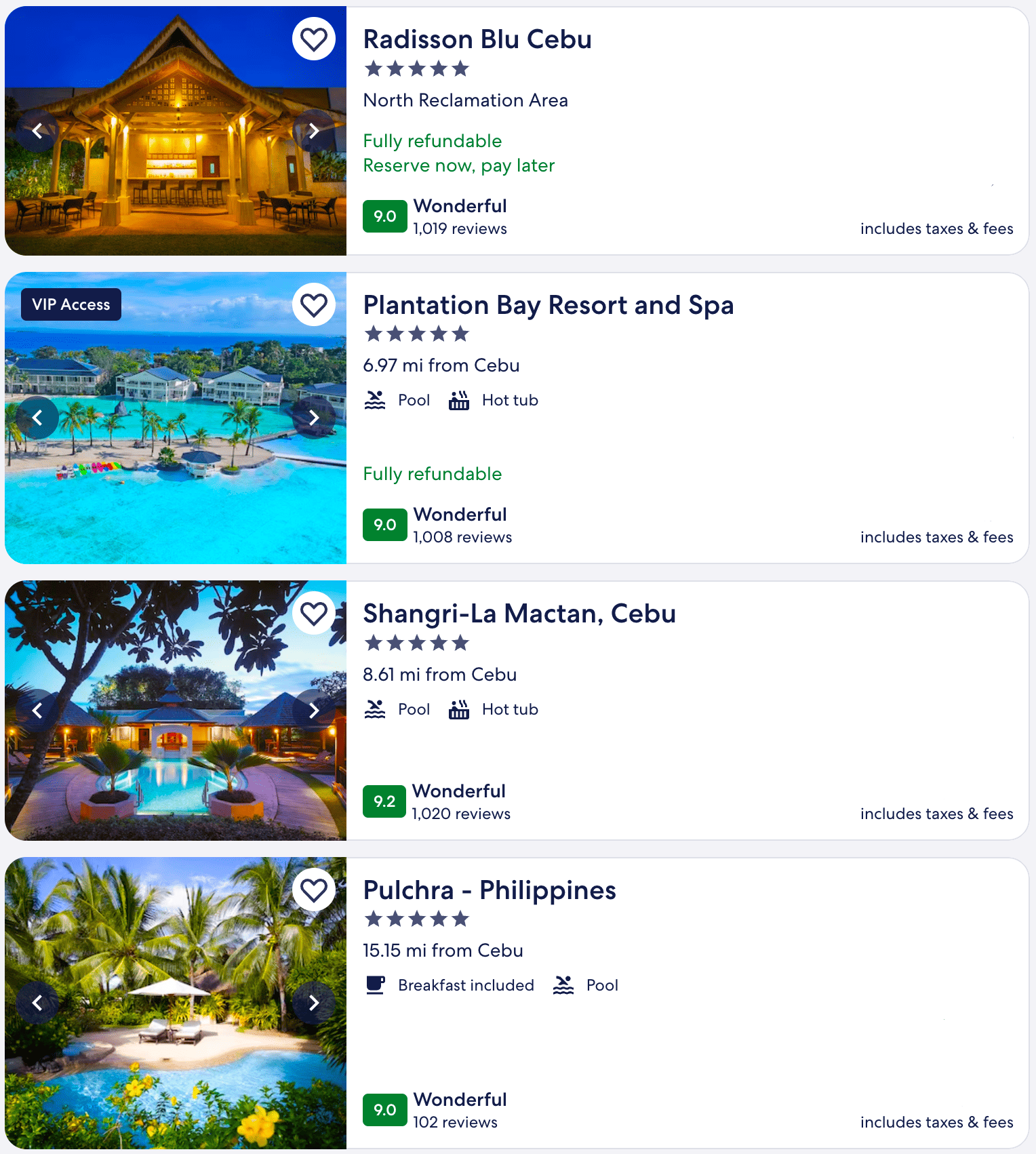
- Shangri-La's Mactan Resort and Spa: Located in Lapu-Lapu City on Mactan Island, this luxurious resort offers private beach access, world-class spa facilities, and a variety of dining options, making it perfect for those seeking a lavish beachfront stay.
- Radisson Blu Cebu: Situated in Cebu City, near the SM City Cebu Mall, Radisson Blu offers a blend of convenience and comfort. With its stylish rooms, superb dining, and excellent service, it's ideal for both business and leisure travelers.
- Abaca Boutique Resort: This exclusive boutique resort in Mactan Island is known for its tranquil atmosphere, exquisite dining, and personalized service, providing a perfect getaway for those seeking privacy and luxury.
- Crimson Resort and Spa Mactan: A stunning beachfront property in Lapu-Lapu City, Crimson Resort offers a tropical paradise with its elegant villas, infinity pool, and a range of recreational activities.
- Marco Polo Plaza Cebu: Perched on Nivel Hills, this hotel offers panoramic views of Cebu City and beyond. Known for its excellent cuisine and sophisticated ambiance, it's a popular choice for travelers seeking a blend of luxury and comfort.
- Plantation Bay Resort and Spa: This sprawling resort in Mactan features one of the largest privately-owned waterways in the world. With its lagoon-style pools and colonial-style buildings, it's a unique destination for families and couples.
- The Henry Hotel Cebu: For a more quirky and artistic stay, The Henry in Cebu City offers a boutique experience with individually themed rooms and a vibrant atmosphere, appealing to those who enjoy a blend of art, culture, and comfort.
- Movenpick Hotel Mactan Island Cebu: Known for its contemporary architecture and Mediterranean-inspired beachfront setting, this hotel in Lapu-Lapu City offers a lively ambiance perfect for travelers seeking a mix of relaxation and entertainment.
- Seda Ayala Center Cebu: Located in the heart of Cebu City's business district, this hotel is ideal for business travelers. With modern amenities, comfortable rooms, and easy access to Ayala Center Cebu, it combines convenience with elegance.
- Bluewater Maribago Beach Resort: This family-friendly resort in Mactan Island boasts of a natural beach, lush tropical gardens, and a variety of leisure facilities, making it an excellent choice for a relaxing and fun-filled vacation.
Each hotel on this list offers a unique slice of the Cebu experience, whether you're looking for luxury, culture, business convenience, or a family getaway. Always remember to check recent reviews and
current travel advisories when planning your trip, as facilities and services may change over time.
Cities on Cebu
- Cebu City
- Mandaue City
- Lapu-Lapu City
- Talisay City
- Toledo City
- Bogo City
- Carcar City
- Naga City
- Danao City
- Mandaue City

Cebu Island Facts:
1. Introduction to Cebu
Nestled in the heart of the archipelago, Cebu stands as a cornerstone of the Philippines, a gem that continually captivates the hearts of those who visit. From its bustling cityscape to the tranquil shores of Cebu Island, this region offers a multifaceted experience that intertwines the modern with the traditional, the urban with the natural.
Cebu: A Brief Overview
Cebu, with its 137 islands and islets, forms a significant part of the Central Visayas region. It's not just an island but an expansive province comprising Cebu Island itself and numerous smaller islands, the most notable being Mactan Island. This province holds an esteemed place in Philippine history, being the site where the Portuguese navigator, Ferdinand Magellan, first set foot in the Philippines, marking it as the first European settlement.
The province’s heart, Cebu City, mirrors the entirety of Cebu’s diversity – a bustling metropolis that proudly retains its historical roots. As the oldest city in the Philippines, Cebu City is a tapestry of rich history and rapid modernization. It's a city where centuries-old churches stand alongside towering skyscrapers, where traditional markets buzz just streets away from upscale shopping centers.
Geographical Context of Cebu Island
Cebu Island, stretching over 196 kilometers from north to south, is the province’s main island. Its narrow shape, spanning only 32 kilometers at its widest point, makes it a unique geographic feature in the Visayas region. The island’s topography is varied – from the rugged mountain ranges traversing its length to the pristine beaches gracing its shores. These white sand beaches, particularly in the southern part of Cebu Island, are among the most celebrated in the Philippines, offering panoramic views of the azure sea.
The northern and southern lengths of Cebu Island present contrasting landscapes. The north is known for its rolling hills and small, quaint towns that dot the coastline. In contrast, the southern part of Cebu Island is more developed, home to some of the most renowned beaches and diving spots in the country.
The Significance of Cebu in the Philippines
Cebu's strategic location in the central Philippines has made it an important commercial, trade, and tourism hub. Historically, it served as a crucial port during the Galleon Trade between the Philippines and Mexico, allowing for the exchange of goods and cultural influences. Today, Cebu continues to be a pivotal economic and cultural center in the southern Philippines, with Cebu City, its capital, often referred to as the “Queen City of the South.”
The province is not only a powerhouse in commerce but also a cradle of Filipino culture. Cebu has been instrumental in shaping the country's history and identity. The blending of indigenous traditions with Spanish, American, and Asian influences has created a unique Cebuano culture, evident in its language, festivals, cuisine, and art.
Cebu also holds a special place in the religious landscape of the Philippines. It is the birthplace of Christianity in the country, with the Basilica del Santo Niño housing the oldest religious relic in the Philippines - the image of the Santo Niño, a representation of the Holy Child Jesus. This revered image symbolizes the Filipino people's deep faith and the beginning of Christianity in the East.
Cebu City: A Mirror of the Province
As the provincial capital, Cebu City reflects the essence of the entire Cebu province. It's a city where the past and present coexist harmoniously, offering a glimpse into the Philippines’ colonial history while showcasing its growth as a modern nation.
Downtown Cebu is a bustling area where the city’s colonial past is most palpable. Here, one can find the remnants of the Spanish era, including old churches and restored colonial buildings. Walking through the downtown area, one can feel the pulse of the city – from the vibrant street vendors to the historic Colon Street, the oldest street in the Philippines.
The city is also a hub for education, industry, and technology, playing a significant role in the national economy. Metro Cebu, encompassing Cebu City and its surrounding towns and cities, is the second-largest metropolitan area in the Philippines. This area has seen rapid development over the years, with the rise of business districts, IT parks, and residential areas.
Conclusion
The introduction to Cebu reveals a province and a city that are as diverse as they are harmonious. Cebu, with its rich history, vibrant culture, stunning natural landscapes, and dynamic urban growth, offers a microcosm of the Philippine experience. A visit to Cebu Island is not merely a journey through a geographic location but an exploration of a rich tapestry of history, culture, and natural beauty, a journey that begins in the heart of the Philippines.
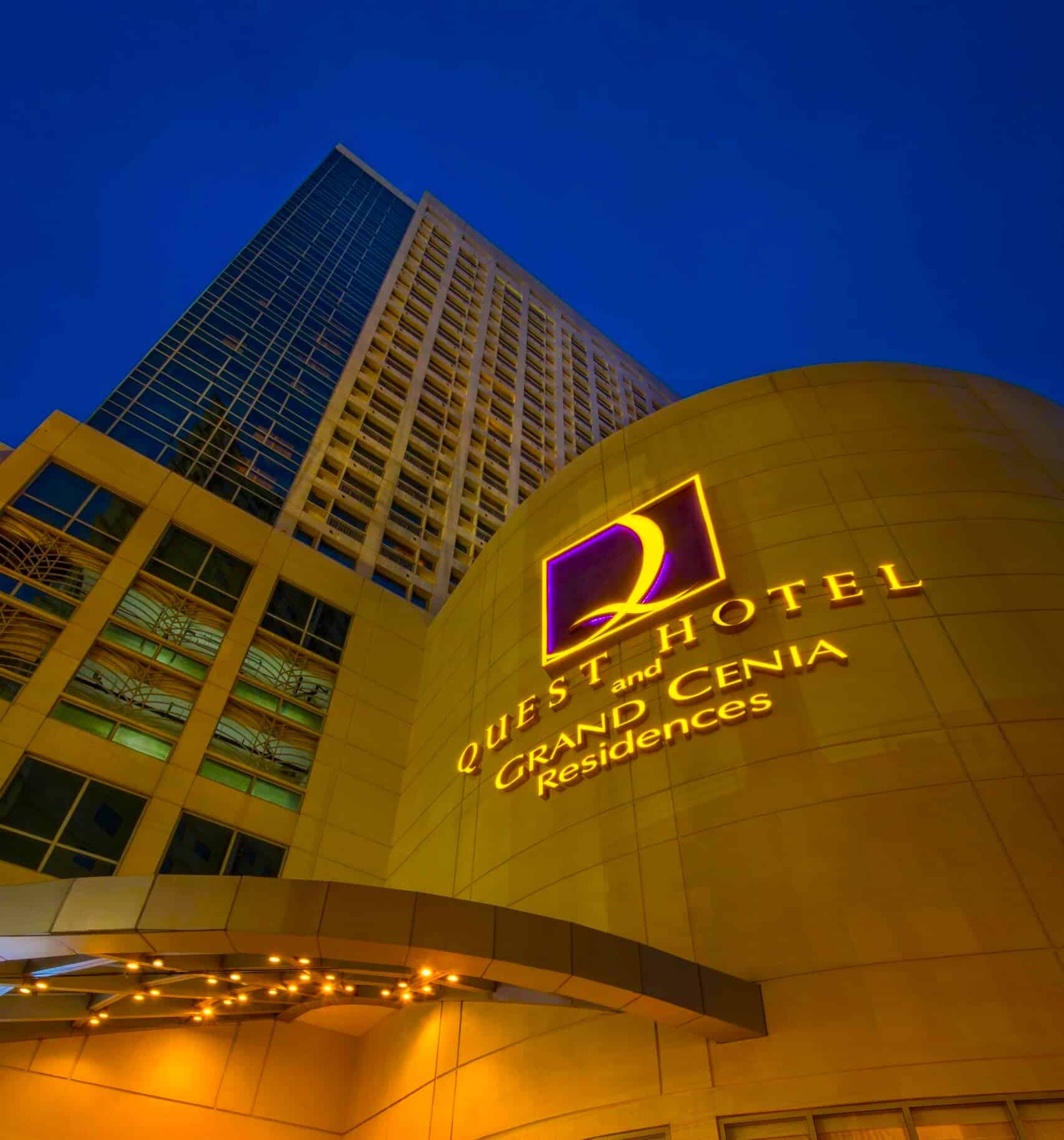
2. The Heart of the City: Cebu City
Cebu City, the pulsating core of Cebu Province, is a remarkable blend of urban sophistication and rich cultural heritage. As the oldest city in the Philippines, Cebu City has evolved from a small fishing village into a bustling metropolis, earning its nickname as the “Queen City of the South.” This section delves into the essence of Cebu City, exploring its downtown area, significant role in Metro Cebu, and its pivotal place in the tapestry of Cebu Philippines.
Downtown Cebu: A Blend of Past and Present
Downtown Cebu is a vibrant area where history and modernity converge. It's a place where one can stroll along Colon Street, the oldest street in the Philippines, flanked by buildings that speak volumes of the city's colonial past. The downtown area is a bustling hub, always alive with the sounds of daily commerce, the vibrant colors of street markets, and the rich aromas of local cuisine.
Here, the traces of Spanish influence are evident in the architecture and layout of the streets. Small, family-owned shops sit alongside grand colonial buildings, some of which have been converted into museums and cultural centers. Downtown Cebu is not just a commercial center; it's a living museum, showcasing the city's evolution from a Spanish settlement to a modern urban hub.
The heart of downtown Cebu is marked by significant landmarks such as the Cebu City Hall, a testament to the city's governance and administrative importance. The City Hall, a structure reflecting the American colonial influence, stands as a symbol of Cebu City's progress and its commitment to serving its people.
Metro Cebu: A Metropolitan Melting Pot
Metro Cebu, extending beyond the boundaries of Cebu City, is a metropolitan area that includes neighboring cities and municipalities. It's the Philippines' second-largest urban area, following Metro Manila, and is a testament to the rapid urbanization and economic growth that the region has experienced.
This area is a melting pot of cultures, a place where traditions from various parts of Cebu Province and beyond converge. It’s a hub of industry, commerce, education, and technology. The presence of numerous universities and colleges makes Metro Cebu a center of education and learning, attracting students from across the Visayas region and the entire country.
Metro Cebu is also a key economic driver in the southern Philippines. It's home to bustling ports, business parks, and a thriving service sector. The region has seen significant investment in infrastructure and real estate, propelling it into a modern urban landscape while still preserving its rich cultural heritage.
Cebu City’s Cultural and Historical Significance
Cebu City is more than just the political and economic capital of Cebu Province; it is the cultural heart of Cebu Philippines. The city is a treasure trove of historical sites, each narrating a chapter of the Philippine story.
The Basilica del Santo Niño, a minor basilica and one of the oldest religious landmarks in the Philippines, is a beacon of Cebu City's historical and cultural identity. This church houses the revered Santo Niño statue, symbolizing the birth of Christianity in the country. The Basilica is not just a place of worship but a monument to the rich religious heritage that Cebu City and the Philippines possess.
Another iconic symbol of Cebu City’s historical tapestry is Magellan's Cross. Planted by Portuguese and Spanish explorers in the 16th century, it marks the spot where Christianity was first introduced to the Philippines. The cross is housed in a chapel next to the Basilica del Santo Niño, forming a historical complex that attracts thousands of visitors yearly.
Cebu City’s history is also prominently showcased in its colonial landmarks. Fort San Pedro, a Spanish fort built in the 16th century, stands as a reminder of the city's strategic importance during the Spanish era. This fort, now a museum, offers a glimpse into Cebu City's colonial past, narrating stories of battles, trade, and the daily life of the Spaniards and locals during that time.
The city's history is further enriched by its role as the first European settlement in the Philippines. The remnants of this era are visible not just in its landmarks but also in the city's layout, its street names, and the enduring influence of Spanish culture in its festivals and daily life.
Conclusion
Cebu City, the heart of Cebu Province, is a dynamic city that beautifully merges its historical past with the demands and vibrancy of modern life. It stands as a testament to the resilience and adaptability of the Cebuano people, embracing change while preserving its rich heritage. As one explores downtown Cebu, ventures through the bustling streets of Metro Cebu, or visits the historic sites that dot the city, one cannot help but be awed by the unique blend of cultures, histories, and experiences that make Cebu City a key pillar in the narrative of Cebu Philippines. This city is not just a place to visit but a destination to experience, to immerse oneself in a story that has been centuries in the making.

3. Historical Landmarks of Cebu
Cebu, a region steeped in history, boasts an array of landmarks that narrate the story of its past. From the time-worn walls of Fort San Pedro to the bustling streets of Colon, these historical sites are not just tourist attractions; they are the living memories of Cebu’s rich and varied history. This section explores these landmarks in detail, offering a journey through time in the streets of Cebu.
Fort San Pedro: A Glimpse into Cebu’s Colonial Past
Fort San Pedro, a bastion of history in Cebu City, stands as a silent witness to the city’s colonial era. Built by the Spaniards in the 16th century, this Spanish fort served as a military defense structure against native uprisings and foreign invaders. Today, the fort is a symbol of Cebu's past, its walls echoing the stories of battles, trade, and the daily life of its occupants.
The fort, now converted into a museum, invites visitors to step back in time. Its corridors and rooms are filled with artifacts and exhibits that showcase Cebu's colonial history. The cannons, still perched on the fort’s walls, and the well-preserved architecture give a vivid picture of what life might have been like during the Spanish era.
Fort San Pedro is not just a remnant of history; it's a place of reflection, where one can ponder the complexities of Cebu’s colonial past and its impact on the present.
Colon Street: The Oldest Street in the Philippines
Colon Street, named after Christopher Columbus (Cristobal Colon in Spanish), is the oldest street in the Philippines. Located in downtown Cebu, this historic street has been the center of trade and commerce since the Spanish era. Today, it is a bustling thoroughfare, lined with shops, markets, and businesses, yet it retains its historic charm.
A walk down Colon Street is like a walk through history. The street has witnessed the transformation of Cebu City from a colonial outpost to a modern urban center. The old buildings, some of which date back to the American period, stand alongside more contemporary structures, creating a unique architectural tapestry.
Colon Street is not just about history; it's a lively part of Cebu's present. The street is always buzzing with activity, from vendors selling local goods to performers entertaining passersby. It’s a place where the past and present of Cebu City intertwine, offering a glimpse into the city's soul.
Magellan’s Cross: A Symbol of Christianity in the Philippines
Magellan's Cross, housed in a chapel next to the Basilica del Santo Niño, is one of the most significant historical landmarks in Cebu. It was planted by Portuguese and Spanish explorers in 1521, marking the introduction of Christianity in the Philippines. This cross is not just a religious symbol; it's a marker of a pivotal moment in Philippine history.
The chapel housing Magellan's Cross is a site of pilgrimage for many. The original cross is encased in a wooden structure to protect it and preserve its legacy. The ceiling of the chapel is adorned with paintings that depict the history of Christianity in Cebu, offering visitors a visual narrative of this significant event.
Magellan’s Cross is a place of reflection, where one can contemplate the profound impact of this moment on the cultural and religious landscape of the Philippines.
Fort San Pedro: A Walk Through History
Returning to Fort San Pedro, one cannot help but be captivated by its historical significance. The fort, once a military fortress, has seen Cebu City evolve through various phases of its history. A visit to the fort is not just about viewing its walls and cannons; it's an immersive experience into the past.
The museum inside the fort houses artifacts that tell the story of Cebu from pre-colonial times to the present. These artifacts, ranging from Spanish documents to old photographs, offer a tangible connection to the past. The fort's gardens, with their serene atmosphere, provide a space for contemplation amid the hustle and bustle of the city.
Conclusion
The historical landmarks of Cebu, from Fort San Pedro to Colon Street and Magellan's Cross, are not just physical structures. They are the embodiment of the city’s journey through time. Each site tells a story, offering insights into the events and people that have shaped Cebu’s identity. These landmarks are a testament to the resilience and enduring spirit of Cebu and its people, serving as a bridge between the past and the present. A visit to these sites is a journey through the annals of Cebu’s history, a journey that reveals the heart and soul of this remarkable region.
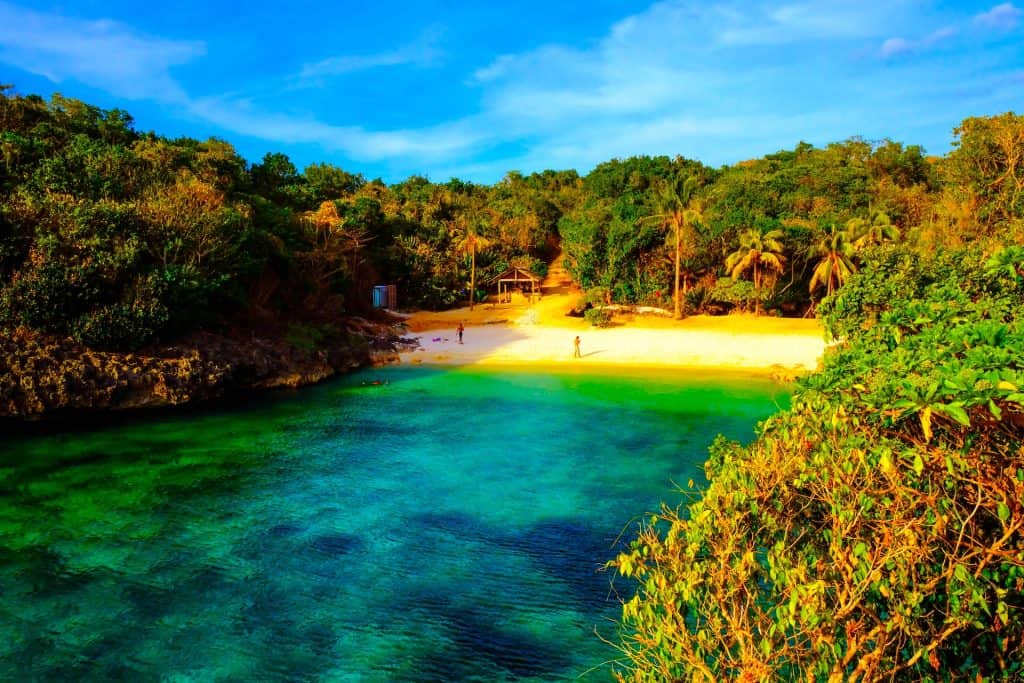
4. Religious and Cultural Sites in Cebu
Cebu, a region rich in cultural and religious heritage, is home to numerous sites that reflect its deep historical roots and diverse cultural influences. This section explores some of the most significant religious and cultural landmarks in Cebu, including the Basilica del Santo Niño, the Taoist Temple, and other important sites that showcase the unique blend of traditions and beliefs in Cebu.
The Basilica del Santo Niño: A Testament to Faith and History
At the heart of Cebu's religious landscape is the Basilica del Santo Niño, a minor basilica that is one of the oldest and most revered religious sites in the Philippines. This historic church houses the Santo Niño de Cebu, a statue of the Holy Child Jesus, which is a celebrated religious relic and an object of deep devotion among Filipinos.
The Basilica del Santo Niño, built on the spot where the Santo Niño statue was found in 1565, symbolizes the birth of Christianity in the Philippines. The annual Sinulog Festival, a vibrant celebration held in honor of the Santo Niño, emanates from this basilica, filling the streets of Cebu City with colorful processions and cultural performances.
Visiting the basilica offers a glimpse into the rich religious heritage of Cebu. The intricate architecture, adorned with religious icons and artworks, tells the story of faith and devotion that has been integral to Cebuano identity for centuries.
The Taoist Temple: A Blend of Traditions and Beliefs
Cebu's cultural diversity is further exemplified by the Taoist Temple, located in Beverly Hills, Cebu City. This temple, built by the Chinese community in 1972, is a symbol of the harmonious blend of different cultures and religious beliefs in Cebu.
The Taoist Temple, with its ornate design and vibrant colors, is not just a place of worship but also a popular tourist attraction. Visitors are welcomed to explore its beautifully landscaped gardens, adorned with statues and structures that reflect Taoist philosophy and art.
The temple offers a panoramic view of Cebu City and serves as a peaceful retreat from the bustling urban life. It is a testament to the multicultural fabric of Cebu, where various traditions and beliefs coexist and enrich the region's cultural tapestry.
Conclusion
The religious and cultural sites of Cebu are more than just tourist destinations; they are living testaments to the region's rich historical and cultural heritage. From the devout atmosphere of the Basilica del Santo Niño to the serene beauty of the Taoist Temple, these sites offer a journey through Cebu's past and present, showcasing the diversity and depth of its cultural landscape. A visit to these landmarks provides an insight into the soul of Cebu, a place where faith, history, and culture intertwine to create a unique and enduring identity.
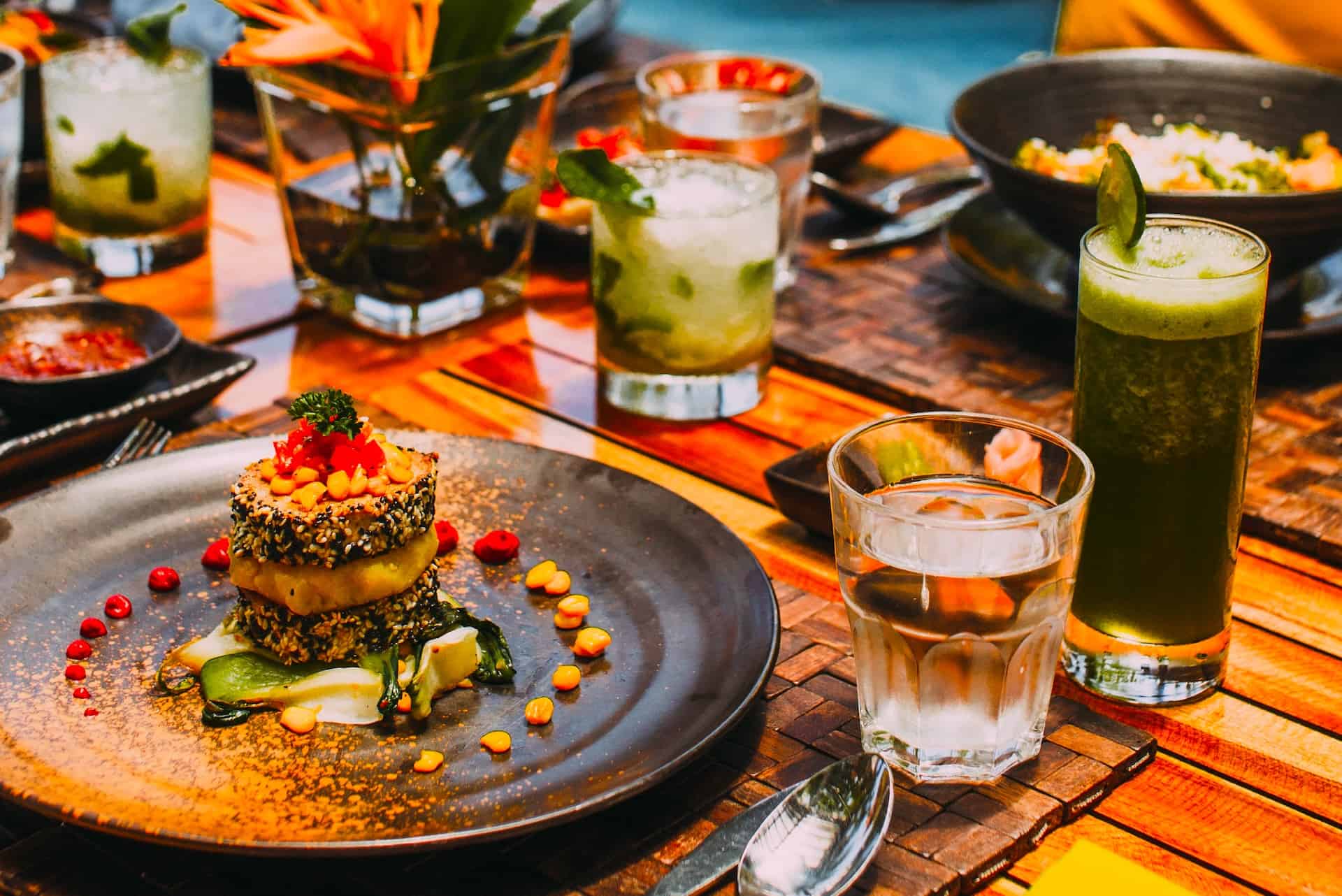
5. Cebu’s Geographical Diversity
Cebu Island, a jewel in the heart of the Philippines, is celebrated not just for its cultural richness but also for its stunning geographical diversity. From the serene beaches in the south to the rugged mountain ranges in the north, the island offers a canvas of natural beauty. This section will explore the contrasting landscapes of northern and southern Cebu, the pristine beaches, and the natural wonders that make Cebu a microcosm of the Philippines' diverse geography.
The Northern Charm of Cebu
The northern part of Cebu Island is characterized by its rolling hills and a more rural, serene ambiance compared to the bustling south. Small towns and villages dot the coastline, each offering a glimpse into the traditional Cebuano way of life. The north is less commercialized, making it a perfect escape for those seeking tranquility and a closer connection with nature.
In the northern tip lies the enchanting Malapascua Island, known for its white sand beaches and as a world-renowned diving destination. Divers from around the globe flock here to experience the unique thrill of swimming with thresher sharks, a rare and exciting encounter.
The Southern Splendor of Cebu
Contrasting the north, the southern part of Cebu Island is more developed and offers a blend of cultural experiences and natural attractions. Here, one finds some of the most famous beaches in Cebu, known for their crystal-clear waters and powdery white sand. The south is also the gateway to several popular diving spots, where the diversity of marine life is simply astounding.
The town of Oslob in southern Cebu has gained international fame for its whale shark watching activities. These gentle giants of the sea attract tourists who wish to experience the unique opportunity of swimming alongside them in their natural habitat.
Cebu's Pristine Beaches and Rugged Mountains
Cebu’s geographical diversity extends to its stunning beaches and imposing mountain ranges. The island’s coastline is dotted with numerous beaches, each offering its unique charm. From the bustling beaches in the vicinity of Mactan Island to the secluded coves hidden along the island's edges, there's a beach in Cebu for every type of traveler.
The island's topography is equally diverse, with rugged mountain ranges traversing its length. These mountains offer not only breathtaking views but also a haven for adventurers and nature lovers. Trails leading up to peaks like Osmeña Peak, the tallest mountain in Cebu, provide an exhilarating experience for hikers and mountaineers.
Conclusion
Cebu Island, with its contrasting northern and southern regions, pristine beaches, and rugged mountain ranges, is a testament to the Philippines' geographical diversity. The island's natural landscapes offer a variety of experiences – from serene beach getaways to adventurous mountain treks. Cebu’s natural beauty, coupled with its rich cultural heritage, makes it a must-visit destination, encapsulating the essence of the Philippine archipelago.
6. Mactan Island: A Hub of Activity
Mactan Island, an integral part of Cebu Province, is a vibrant testament to the region's dynamic blend of history, culture, and modernity. Connected to Cebu City by the Marcelo Fernan Bridge and the Mactan-Mandaue Bridge, Mactan is more than just a gateway to Cebu; it's a destination in its own right. This section explores the historical significance, cultural diversity, and economic importance of Mactan Island.
The Historical Significance of Mactan
Mactan Island holds a special place in Philippine history, most notably as the site of the Battle of Mactan. This historic event is where the local chieftain Lapu-Lapu famously defeated the Portuguese explorer Ferdinand Magellan in 1521, marking a significant moment in the country's resistance against colonial forces.
The island pays homage to this heritage through various landmarks and memorials, including the Lapu-Lapu Monument, which stands as a symbol of Filipino bravery and independence. This historical context adds a profound depth to the experience of visiting Mactan, connecting visitors to a pivotal moment in Philippine history.
Mactan's Role in Modern Cebu
In contemporary times, Mactan has evolved into a bustling hub within Cebu Province. The Mactan Cebu International Airport, located on the island, is the second busiest airport in the Philippines and serves as a vital gateway to the Visayas region. This airport has played a crucial role in the economic and tourism growth of Cebu, connecting the island to major cities worldwide.
Beyond its airport, Mactan Island has developed into a thriving economic zone. The island is home to a number of industrial parks, export processing zones, and a growing IT sector. This economic growth has transformed Mactan into a busy, dynamic area, contributing significantly to the overall progress of Metro Cebu.
Mactan's Cultural and Recreational Offerings
Mactan Island is also renowned for its rich cultural offerings and recreational activities. The island is dotted with high-end resorts, white sand beaches, and world-class diving spots, making it a popular destination for both local and international tourists.
The cultural landscape of Mactan is diverse, reflecting the island's history and its modern evolution. Visitors can explore a range of attractions, from historical sites related to the Battle of Mactan to contemporary art galleries and craft centers showcasing the work of local artisans.
Conclusion
Mactan Island is a microcosm of the dynamism and diversity of Cebu. From its historical significance as the site of a pivotal battle to its modern role as an economic and cultural hub, Mactan embodies the spirit of progress and resilience that characterizes Cebu. Whether one is interested in exploring the rich history of the Philippines, enjoying the natural beauty of its beaches, or experiencing the vibrancy of its modern developments, Mactan Island offers a unique and enriching experience to all who visit.
7. Cebu’s Natural Wonders
Cebu is not only a cultural and historical hub but also a place of incredible natural beauty. This section delves into the natural wonders of Cebu, from the majestic Kawasan Falls to the highest point of the island, Osmeña Peak. The diversity of its landscapes – ranging from tumbling waterfalls to serene beaches – makes Cebu a paradise for nature lovers and adventurers alike.
The Enchanting Kawasan Falls
Kawasan Falls, located in Badian, is one of Cebu’s most famous natural attractions. This multi-layered waterfall is known for its turquoise waters and serene ambiance. The journey to the falls is an adventure in itself, involving a hike through lush forests and alongside a gently flowing river.
Upon reaching Kawasan Falls, visitors are greeted by the sight of water cascading down into a series of natural swimming pools. The main waterfall is a spectacular sight, with its water dropping from a height of over 40 meters into a large, clear pool perfect for swimming. The surrounding natural landscape adds to the charm of Kawasan Falls, making it a must-visit destination for anyone traveling to Cebu.
Osmena Peak: Cebu’s Tallest Mountain
Osmena Peak, standing at over 1,000 meters above sea level, is the tallest mountain in Cebu. Located in the town of Dalaguete, Osmena Peak is part of the Mantalungon range, often referred to as the “Little Baguio” of Cebu due to its cooler climate and vegetable farms.
The hike to Osmena Peak is relatively easy, making it accessible to both seasoned hikers and beginners. The reward at the summit is a breathtaking panoramic view of Cebu’s rugged coastline, neighboring islands, and rolling hills. The unique jagged hills surrounding the peak, reminiscent of the Chocolate Hills of Bohol, provide a stunning backdrop for photos and a serene environment for nature appreciation.
Tumalog Falls: A Hidden Gem
Tumalog Falls, located near Oslob, is another natural wonder of Cebu. This waterfall is unique due to its gentle cascade over a wide, moss-covered cliff. The water forms a misty curtain and pools into a shallow, refreshing lagoon at the base.
Visiting Tumalog Falls offers a tranquil experience, as the falls are often less crowded than other tourist spots. The surrounding rainforest adds to the peaceful atmosphere, making it an ideal spot for relaxation and connection with nature.
The Beaches of Cebu: Natural Splendor
No discussion of Cebu’s natural wonders would be complete without mentioning its beaches. The island is fringed with numerous beaches, each offering its own unique charm. From the bustling shores of Mactan Island to the secluded white sand beaches of Malapascua and Bantayan Islands, Cebu’s beaches are a testament to the island’s natural beauty.
These beaches are not just for relaxation; they offer a variety of water activities, such as snorkeling, diving, and swimming with whale sharks. The clear waters and rich marine life of Cebu’s seas make it a haven for underwater enthusiasts.
Conclusion
Cebu’s natural wonders are as diverse as they are breathtaking. From the majestic Kawasan Falls and the serene Tumalog Falls to the awe-inspiring views from Osmena Peak and the idyllic beaches, Cebu is a treasure trove of natural beauty. These natural attractions, each offering a unique experience, highlight the island's rich environmental heritage and make Cebu a must-visit destination for nature lovers and adventure seekers.
8. Adventure and Leisure Activities in Cebu
Cebu is not only a place of historical and natural beauty but also a hub for adventure and leisure. This section explores the various activities that Cebu offers, from the thrilling experience of swimming with whale sharks to the serene enjoyment of scuba diving in its crystal-clear waters. The island's unique combination of natural landscapes, from the majestic seas to the tranquil beaches, makes it an ideal destination for a wide range of leisure activities.
Whale Shark Watching in Oslob
One of Cebu’s most thrilling attractions is the opportunity to swim with whale sharks in Oslob. These gentle giants of the sea are a magnificent sight, and the chance to interact with them in their natural habitat is a unique and unforgettable experience. In the waters off Oslob, visitors can snorkel or dive with these majestic creatures, witnessing their graceful movements up close.
This activity not only provides an adrenaline rush but also an opportunity to learn about the marine ecosystem and the importance of conserving these magnificent animals. The whale shark watching industry in Oslob is also a testament to the community’s efforts in sustainable tourism and marine conservation.
Scuba Diving: Exploring Underwater Wonders
Cebu is a paradise for scuba divers, offering a plethora of dive sites that cater to all levels of experience. The island’s diverse marine life, vibrant coral reefs, and clear waters make it an ideal destination for underwater exploration. From the beginner-friendly sites around Mactan Island to the more challenging dives at Malapascua Island, home to the elusive thresher sharks, Cebu has something to offer every diver.
Diving in Cebu is not just an activity; it's an exploration of an underwater world teeming with life. The experience of floating amidst colorful fish, intricate coral formations, and occasionally, shipwrecks, is both exhilarating and serene.
The Charm of Malapascua Island
Malapascua Island, off the northern tip of Cebu, is a haven for divers and beach lovers alike. The island is renowned for its white sand beaches, crystal-clear waters, and laid-back atmosphere. It’s particularly famous for being one of the few places in the world where divers can regularly see thresher sharks, making it a must-visit destination for diving enthusiasts.
But Malapascua is not just about diving. The island’s beauty extends to its pristine beaches, such as Bounty Beach, where visitors can relax and enjoy the tranquil environment. The sunsets on Malapascua are particularly breathtaking and provide a perfect end to a day full of adventure.
Panagsama Beach: A Blend of Relaxation and Adventure
Panagsama Beach in Moalboal is another popular destination for those seeking a mix of relaxation and adventure. The beach is famous for its sardine run, a natural phenomenon where millions of sardines form huge underwater clouds, creating a mesmerizing spectacle for divers and snorkelers.
Besides the sardine run, Panagsama Beach is also a great spot for relaxation. The beachfront is lined with resorts, restaurants, and bars, making it a lively place to unwind after a day of water activities. The vibrant coral reef just offshore is an additional attraction, easily accessible for snorkelers.
Conclusion
Cebu’s adventure and leisure activities offer something for every kind of traveler. Whether it’s the thrill of swimming with whale sharks, the awe of scuba diving amongst vibrant marine life, the serene beauty of Malapascua Island’s beaches, or the unique experience of the sardine run at Panagsama Beach, Cebu provides a plethora of options for those seeking both adventure and relaxation. These activities not only highlight the natural beauty of Cebu but also its commitment to sustainable and responsible tourism.
9. Cebu’s Urban Expansion
Cebu, known for its rich history and natural beauty, is also a region experiencing dynamic urban expansion. This section delves into the growth and development of Cebu Province, including the bustling Mandaue City, the evolving landscape of the North Reclamation Area, and the burgeoning South Road Properties. These areas exemplify the rapid urbanization and modernization shaping the region.
The Growth of Cebu Province
Cebu Province has seen remarkable growth over the past decades, transitioning from a primarily agricultural base to a diversified economy with robust industries, tourism, and services. This transformation is most evident in its urban centers, where infrastructure development, commercial establishments, and residential areas are rapidly evolving.
The province's capital, Cebu City, is at the forefront of this growth. It serves as the economic and cultural heart of the region, driving development in surrounding areas. The expansion of business districts and IT parks in Cebu City has contributed significantly to the province's economic progress.
Mandaue City: An Emerging Urban Center
Mandaue City, part of Metro Cebu, is a testament to the region's urban expansion. Once a quiet municipality, Mandaue has grown into a bustling city with a thriving industrial sector. The city is home to several industrial parks and is a major center for furniture manufacturing, contributing significantly to the Philippine economy.
Mandaue City is not just an industrial hub; it has also seen considerable growth in commerce and residential developments. The city's strategic location, connecting mainland Cebu to Mactan Island, makes it a vital link in the region's transportation and logistics network.
The North Reclamation Area: Transforming the Urban Landscape
The North Reclamation Area in Cebu City is a prime example of urban redevelopment. This area, once a marshland, has been transformed into a vibrant commercial and residential hub. The development includes shopping malls, office buildings, and condominiums, reshaping the city's skyline and providing new opportunities for business and living.
This area's development is a significant step in Cebu's urban planning, showcasing how thoughtful reclamation and development projects can contribute to the region's growth and modernization.
South Road Properties: A Vision for the Future
The South Road Properties (SRP), a large-scale development project in Cebu City, represents the future of urban development in the region. This area is being developed into a mixed-use urban zone, with plans for residential areas, business centers, shopping complexes, and recreational facilities.
The SRP project is not just about expanding the city's urban space; it's about creating a sustainable and integrated urban environment. The development is designed with modern urban planning principles, aiming to provide a balanced mix of commercial, residential, and green spaces.
Conclusion
The urban expansion of Cebu Province, from the bustling growth of Mandaue City to the transformative projects in the North Reclamation Area and South Road Properties, reflects the region's evolution into a modern urban landscape. These developments are not just changing the physical appearance of Cebu; they are also creating new opportunities for business, living, and recreation, contributing to the overall progress and modernization of the region. The urban growth of Cebu is a testament to its adaptability and forward-thinking approach, positioning it as a key player in the Philippines' economic and urban development.
10. Culture and Heritage of Cebu
Cebu's culture and heritage are as rich and diverse as its history. This section explores the cultural landmarks and heritage sites of Cebu, including the Casa Gorordo Museum and the various colonial landmarks, reflecting the island's historical journey from a Spanish settlement to a modern Filipino city.
Casa Gorordo Museum: A Window to Cebu's Past
The Casa Gorordo Museum, located in the historic Parian district of Cebu City, is a significant cultural landmark. This museum, once a private home, has been meticulously preserved and converted into a public museum, offering visitors a glimpse into the lifestyle of a Filipino family during the late 19th and early 20th centuries.
The house, originally built in the 1850s, is a fine example of Spanish-Filipino architecture. It features a blend of native Cebuano, Spanish, and Chinese influences, evident in its design and furnishings. The museum not only showcases antique furniture and household items but also provides insights into the customs, traditions, and daily life of Cebuanos during the colonial period.
Colonial Landmarks: Echoes of Spanish Influence
Cebu's colonial landmarks are testaments to its history as the first Spanish settlement in the Philippines. These landmarks include the Basilica del Santo Niño, Fort San Pedro, and Magellan's Cross, each playing a significant role in the island's historical narrative.
The Basilica del Santo Niño, housing the revered Santo Niño statue, is more than a religious icon; it's a symbol of the introduction of Christianity in the Philippines. Fort San Pedro, the oldest fort in the Philippines, speaks of Cebu's strategic importance during the Spanish era. Magellan's Cross, marking the spot where Christianity was first introduced, is a historical beacon.
The Holy Child: A Symbol of Faith and Unity
The image of the Santo Niño (Holy Child) is deeply ingrained in Cebu's cultural and religious fabric. The annual Sinulog Festival, a vibrant celebration in honor of the Santo Niño, is a significant cultural event that attracts thousands of visitors to Cebu. The festival features colorful parades, traditional dances, and elaborate costumes, showcasing the rich cultural heritage of Cebu.
The devotion to the Santo Niño transcends religious boundaries and is a unifying symbol for Cebuanos, reflecting the island's deep-rooted faith and community spirit.
Conclusion
Cebu's culture and heritage, from the Casa Gorordo Museum to its colonial landmarks and the veneration of the Santo Niño, paint a vivid picture of the island's historical journey. These cultural and heritage sites are not just attractions; they are living museums that tell the story of Cebu's transformation from a Spanish settlement to a vibrant Filipino city. Exploring these sites offers a deeper understanding of Cebu's unique identity, formed by a blend of historical influences and a strong sense of community and faith.
11. Modern Cebu: Development and Tourism
Cebu's journey from a historical island to a modern urban center is a story of remarkable transformation. This section explores the contemporary developments in Cebu, highlighting its emergence as a hub for luxury hotels, popular attractions, and the allure of its nearby islands. These elements collectively showcase Cebu's blend of tradition and modernity, making it a unique destination in the Philippines.
The Rise of Luxury Hotels
In recent years, Cebu has seen a surge in the development of luxury hotels, catering to the growing number of tourists and business travelers. These hotels are not just places of accommodation but are destinations in themselves, offering world-class amenities, exquisite dining experiences, and impeccable service.
Located in key areas such as Cebu City and Mactan Island, these luxury hotels provide a gateway to the island's attractions while offering a tranquil retreat from the hustle and bustle. They are a testament to Cebu's growing prominence as a global tourist destination.
Popular Attractions in Cebu
Cebu is home to a myriad of attractions that appeal to a wide range of interests. From historical sites like Magellan's Cross and Fort San Pedro to natural wonders such as Kawasan Falls and Osmena Peak, there is no shortage of things to see and do in Cebu.
For those interested in cultural experiences, the heritage sites in downtown Cebu and the vibrant Sinulog Festival offer a glimpse into the island's rich history and traditions. For adventure seekers, activities like canyoneering in Badian and island-hopping around Mactan offer thrilling experiences.
Exploring the Nearby Islands
Cebu's location in the central Visayas region makes it an ideal starting point for exploring the nearby islands. Each island offers a unique experience, from the diving paradises of Malapascua and Moalboal to the pristine beaches of Bantayan and Camotes Islands.
These islands are easily accessible from Cebu and offer a diverse range of activities, from snorkeling and diving to simply relaxing on the beach. They are a crucial part of Cebu's tourism appeal, adding to the island's allure as a comprehensive travel destination.
Conclusion
Modern Cebu, with its luxurious hotels, array of popular attractions, and the enchanting nearby islands, represents the dynamic and multifaceted nature of the island. These developments have not only transformed Cebu into a contemporary urban area but have also enhanced its appeal as a top tourist destination. The balance between preserving its rich cultural heritage and embracing modernity is what makes Cebu a unique and captivating place to visit.
12. Cebu City Hall and Governance
Cebu City, as the heart of the province, not only boasts cultural and historical significance but also serves as a central point for governance and administration. This section focuses on the role of the Cebu City Hall in local governance, reflecting the city's journey from a colonial outpost to a modern metropolis.
The Role of Cebu City Hall in Governance
Cebu City Hall, located in the historic center of Cebu City, is more than just an administrative building; it is a symbol of the city's governance and civic pride. The hall is the epicenter of local government activities, playing a crucial role in shaping the policies and initiatives that drive the city's development.
The building itself is an architectural landmark, reflecting the blend of Cebu's past and present. It is here that the city's leaders make decisions that impact the lives of its citizens, from urban planning and infrastructure development to cultural preservation and tourism.
Cebu City Hall's Contribution to Urban Development
Cebu City Hall has been instrumental in spearheading various urban development projects that have transformed the cityscape. These projects range from road expansions and public transportation improvements to the development of public spaces and the preservation of heritage sites.
The city's efforts in sustainable urban development, facilitated by the city hall, have been critical in managing the challenges of rapid urbanization. These initiatives aim to enhance the quality of life for residents while maintaining the city's unique cultural identity.
Governance in the Context of a Growing City
As Cebu City continues to grow and evolve, the role of the city hall in governance becomes increasingly significant. Balancing the needs of a growing population with the preservation of the city's heritage and natural resources is a complex task.
Cebu City Hall's governance approach reflects an understanding of these challenges. It focuses on inclusive and sustainable development, ensuring that the city's growth benefits all residents while preserving the cultural and natural heritage that makes Cebu unique.
Conclusion
The Cebu City Hall is more than just the center of governance; it is a testament to the city's ability to adapt and grow while staying true to its roots. The hall's role in administering and guiding Cebu City's development is crucial in shaping a future that respects the past while embracing modernity. In the midst of rapid change, Cebu City Hall stands as a beacon of responsible governance, steering the city towards a balanced and prosperous future.
13. Cebu in the Broader Philippine Context
Cebu's role in the broader context of the Philippines is multifaceted, reflecting its historical, cultural, and economic significance. This section explores Cebu's place in the Southern Philippines, its influence in the Visayas region, and its contributions to the larger narrative of the Philippines.
Cebu's Place in the Southern Philippines
Located in the Central Visayas, Cebu is a vital part of the Southern Philippines, both geographically and culturally. The province's strategic location has historically made it a critical point for trade and cultural exchange. Cebu's ports have been gateways connecting the Philippines with the rest of the world, facilitating the flow of goods, ideas, and cultures.
Influence in the Visayas Region
Cebu's influence extends throughout the Visayas region, where it is seen as a center of economic and cultural activity. The province has played a significant role in shaping the region's history, from the arrival of the Portuguese navigator Ferdinand Magellan to the present day.
The cultural practices, festivals, and traditions of Cebu are celebrated throughout the Visayas, highlighting the province's role in shaping the cultural identity of the region. The Sinulog Festival, in particular, is a major cultural event that attracts visitors from across the Visayas and beyond.
Contribution to the Philippine Narrative
Cebu's contributions to the Philippines are numerous and varied. As the site of the first European settlement in the country, Cebu holds a special place in Philippine history. The events that took place on the island have had a lasting impact on the nation's trajectory.
Economically, Cebu is a powerhouse in the Philippines. Its industries, from furniture making to technology and business process outsourcing, contribute significantly to the national economy. The province's robust tourism industry also plays a crucial role, showcasing the natural beauty and rich cultural heritage of the Philippines to the world.
Conclusion
Cebu's significance in the broader context of the Philippines is undeniable. Its historical, cultural, and economic contributions have shaped the narrative of the Southern Philippines and the entire nation. Cebu is a microcosm of the Philippines' diversity and resilience, a province that embodies the rich tapestry of history, culture, and progress that defines the Filipino nation.
14. Cebu’s Economic Landscape
Cebu’s economic landscape is as diverse as its natural and cultural heritage. This section delves into the various economic facets of Cebu, from its rich fishing grounds and agricultural base in the southern part to the bustling industrial and commercial activities in the urban centers. The section also explores Cebu's position in the Philippines' maritime and export economy, highlighting its strategic location and natural resources.
The Fishing Industry and Maritime Economy
Cebu's geographical location, surrounded by the sea, has naturally led to a robust fishing industry. The rich fishing grounds around the island provide a significant source of livelihood for many locals and contribute to the food security of the region. The variety and abundance of marine life in Cebu's waters make it an important player in the Philippines' maritime economy.
Agriculture and Trade in Southern Cebu
The southern part of Cebu Island, with its fertile land and favorable climate, is a stronghold of agricultural activity. This area produces a variety of crops, including corn, rice, and vegetables, supporting both local consumption and export.
Cebu's agricultural produce not only feeds its population but also contributes to the province's trade and economy. The export of agricultural goods adds to the economic diversity of Cebu, showcasing its ability to balance traditional industries with modern developments.
Industrial Growth and Urban Development
Cebu's economic landscape is marked by significant industrial growth, especially in and around its urban centers. The development of industrial parks and the growth of sectors like manufacturing, IT, and business process outsourcing reflect the dynamic nature of Cebu's economy.
This industrial growth has spurred urban development, transforming cities like Cebu City and Mandaue into bustling urban hubs. The infrastructure development accompanying this growth has improved connectivity and accessibility, further boosting economic activities.
Cebu’s Role in Philippine Exports
Cebu's strategic location in the central Visayas makes it a key player in the Philippines' export economy. The island's ports facilitate the movement of goods, linking Cebu with national and international markets. Cebu is known for exporting various products, including furniture, fashion accessories, and food products, reflecting the diversity and innovation of its industries.
Conclusion
Cebu's economic landscape is a complex tapestry of traditional and modern elements. From its fishing and agricultural roots in the south to the bustling industrial and commercial activities in its urban centers, Cebu demonstrates a unique ability to adapt and thrive in a changing economic environment. This economic dynamism, coupled with its strategic location and rich natural resources, positions Cebu as a key economic hub in the Philippines, driving both regional and national growth.
15. Conclusion: The Essence of Cebu
In concluding our extensive exploration of Cebu, it's evident that this island province is not merely a geographic location but a vibrant tapestry of history, culture, nature, and modernity. This final section encapsulates the essence of Cebu, highlighting why it is a must-visit destination and how it reflects the broader narrative of the Philippines.
The Allure of Visiting Cebu Island
Cebu Island beckons visitors with its unique blend of attractions. From the historical landmarks in Cebu City to the pristine beaches of its surrounding islets, Cebu offers a diverse range of experiences. The cultural richness, seen in festivals like Sinulog, and the natural beauty, from the heights of Osmeña Peak to the depths of its marine sanctuaries, make Cebu a microcosm of the Philippine archipelago.
Cebu: A Fusion of Past and Present
Cebu stands as a testament to the Philippines' dynamic history and its journey towards modernity. The remnants of its role as the first European settlement in the Philippines coexist with the signs of its contemporary urban development. The province's ability to preserve its past while embracing the future is evident in its well-preserved historical sites, thriving arts scene, and booming economy.
Cebu’s Global Connections
Cebu’s significance extends beyond its shores. Historically a vital port in the Galleon Trade, connecting the Philippines with Mexico and the rest of the world, Cebu continues to be an important economic and cultural link globally. Its international airport and seaports serve as gateways, bringing in tourists and facilitating global trade.
The Diverse Landscape of Cebu
Cebu's geographical diversity, from its rugged mountains to white sand beaches, offers a haven for all types of travelers. The island's natural landscapes are not only visually stunning but also provide venues for various recreational activities, from hiking and bird watching to diving and beach lounging.
Cebu's Contribution to the Philippine Identity
Finally, Cebu contributes significantly to the national identity of the Philippines. Its historical significance, cultural richness, economic vitality, and natural beauty all contribute to the narrative of the Philippines as a nation. Cebu is a shining example of the Filipino spirit – resilient, diverse, and vibrant.
Conclusion
Cebu is more than just a destination; it's a journey through time, culture, and nature. Its ability to offer something for everyone, from history enthusiasts and cultural aficionados to nature lovers and adventure seekers, makes it a unique and unforgettable part of the Philippines. The essence of Cebu lies in its diversity, its balance of tradition and modernity, and its warm, welcoming spirit, making it a quintessential representation of the Filipino experience.
Sources : https://en.wikipedia.org/wiki/Cebu


